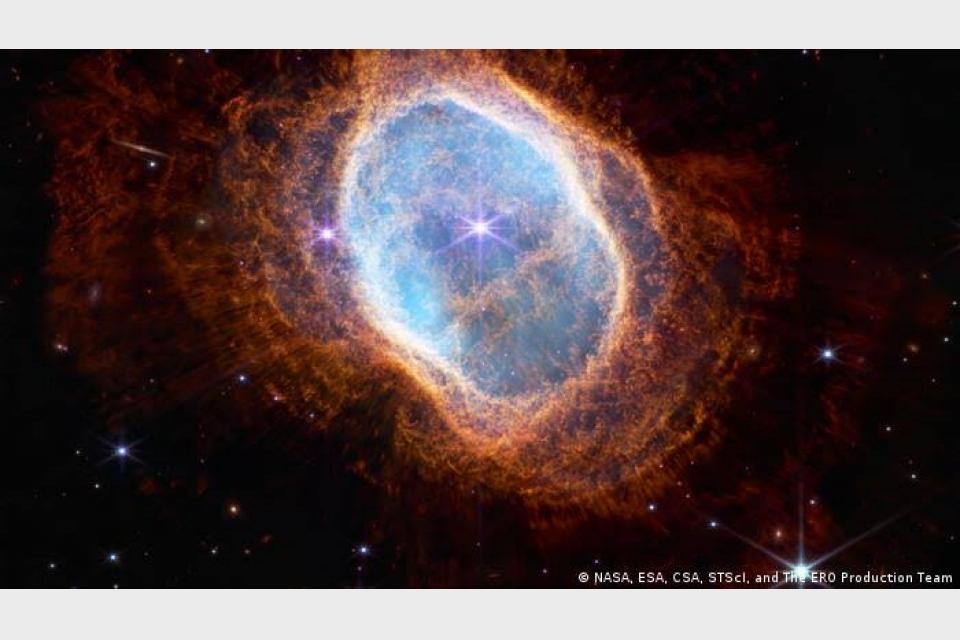Full-color images from NASA's James Webb Space Telescope were released on Tuesday, providing a glimpse of what the early Universe looked like.
The images are some of the most detailed pictures of the Cosmos ever captured.
They provide views of five targets: galaxy cluster SMACS 0723, the gas planet WASP-96 b, the Southern Ring Nebula, the Stephan's Quintent galaxy group and the Carina Nebula.
A teaser image, released Monday, showed the galaxy cluster SMACS 0723 as it appeared 4.6 billion years ago, NASA said in a press release. The combined mass of the galaxy cluster acts as a gravitational lense and magnifies much more distant galaxies behind it.
"If you held a grain of sand on the tip of your finger at arm’s length, that is the part of the universe you're seeing [in this image]. Here, you're seeing galaxies shining around other galaxies whose light has been bent," said NASA Administrator Bill Nelson.
Inhabitable planets?
Webb also showed atmospheric analysis of a giant exoplanet called WASP-96 b— a gas planet that orbits a star outside our solar system.The planet, located nearly 1,150 light-years from Earth, orbits its star every 3.4 days. It has about half the mass of Jupiter, and its discovery was announced in 2014.
This near-infrared spectrograph shows the atmospheric properties of WASP-96b2. This splits near-infrared light into its components. Like a barcode, this helps scientists to read whether a planet could be inhabitable or not.
"[The James Webb Space Telescope] is so precise we're going see whether or not planets are habitable, because we can determine the chemical composition of their atmospheres," Nelson said.
James Webb Space Telescope has captured the distinct signature of water, along with evidence for clouds and haze, in the atmosphere surrounding a hot, puffy gas giant planet orbiting a distant Sun-like star. Like a barcode, this helps scientists to read whether a planet could be inhabitable or not.
The last breath of a dying star
In the next image, Webb showed the Southern Ring Nebula, capturing a dying star illuminating clouds of gas and dust of the nebula.
The Southern Ring, or "Eight-Burst" nebula, is a planetary nebula – an expanding cloud of gas, surrounding a dying star. It is nearly half a light-year in diameter and is located approximately 2,000 light years away from Earth.
The Southern Ring Nebula in near- and mid-infrared light, illuminated by a dying star
Hot ionized gas is heated by the hot core of the star, creating the blue haze. Holes in the inner nebula allow the central stars to come out, illuminating the nebula like patchy clouds with the sun shining through.
Baby photos of stars
Webb also showed five galaxies in Stephan's Quintent. Each galaxy contains millions or hundreds of millions of stars. The galaxies are about 300 million light-years away from us, locked in a cosmic dance, held together by gravitational forces.
The cosmic dance of five galaxies in Stephan's Quintet
This image shows the evolution of the different galaxies. This image shows the process of stars being born and evolving. The huge cliff of cliffs of gas and dust are the building blocks of stars and planets.
About 290 million light-years away, Stephan's Quintet is located in the constellation Pegasus. It is notable for being the first compact galaxy group ever discovered. Four of the five galaxies within the quintet are locked in a cosmic dance of repeated close encounters.
The final image revealed from Webb showed the cosmic cliffs in the Carina Nebula, with hundreds of new stars we have never seen before.
Massive foreground galaxy clusters magnify and distort the light of objects behind them, allowing us to see extremely distant and faint galaxies.
A more accurate history of the universe
The new images have more than just aesthetic value. The images from Hubble, Webb's predescessor, were crucial in helping scientists understand how planets, stars, and galaxies are formed. It even helped to get a more accurate date of birth for the Universe — about 13.8 billion years ago.
Hubble is still in operation, but the new technological advancements built into the James Webb Space Telescope will further deepen the world's knowledge of the universe, and more efficiently.
"With Hubble, it took two weeks of continuous imaging to get detailed images, but with Webb we took the image before breakfast," said Webb operations scientist Jane Rigby in today's press release.
Webb is set to tell us about the Universe's origins farther than ever before, from the formation of stars and planets, to the birth of the first galaxies in the early universe.
How does the telescope work?
The James Webb Space Telescope is the next great space science observatory following Hubble, designed to answer outstanding questions about the Universe and make breakthrough discoveries in all fields of astronomy.
The joint project between the American space agency NASA, and the European and Canadian space agencies (ESA, CSA)launched in December 2021.
The telescope uses infrared thermal camerasto capture parts of the electromagnetic spectrum invisible to the naked eye. Infrared allows astronomers to see through dust clouds that would otherwise block out the view.
The current location of the space telescope can be tracked here: https://webb.nasa.gov/content/webbLaunch/whereIsWebb.html









